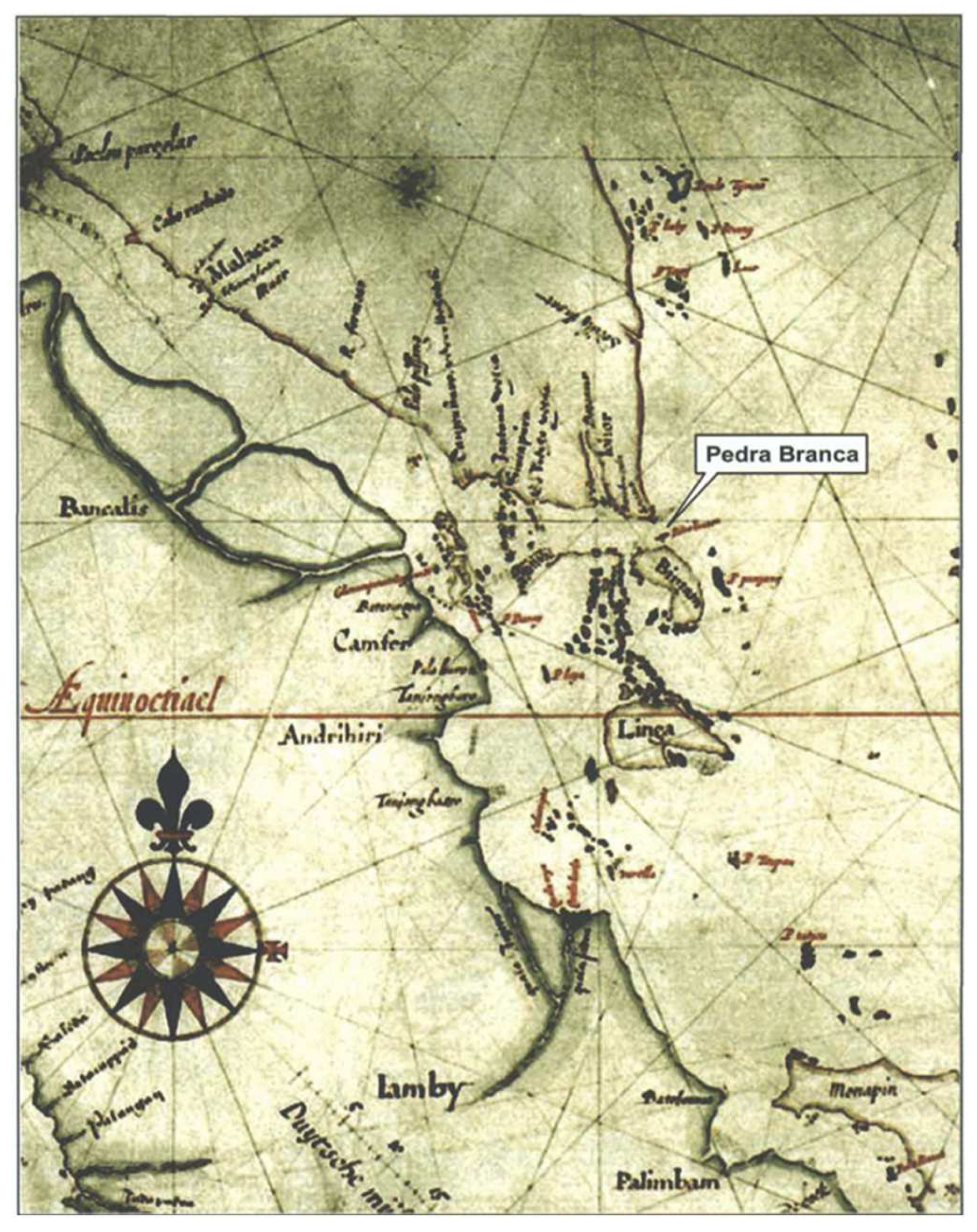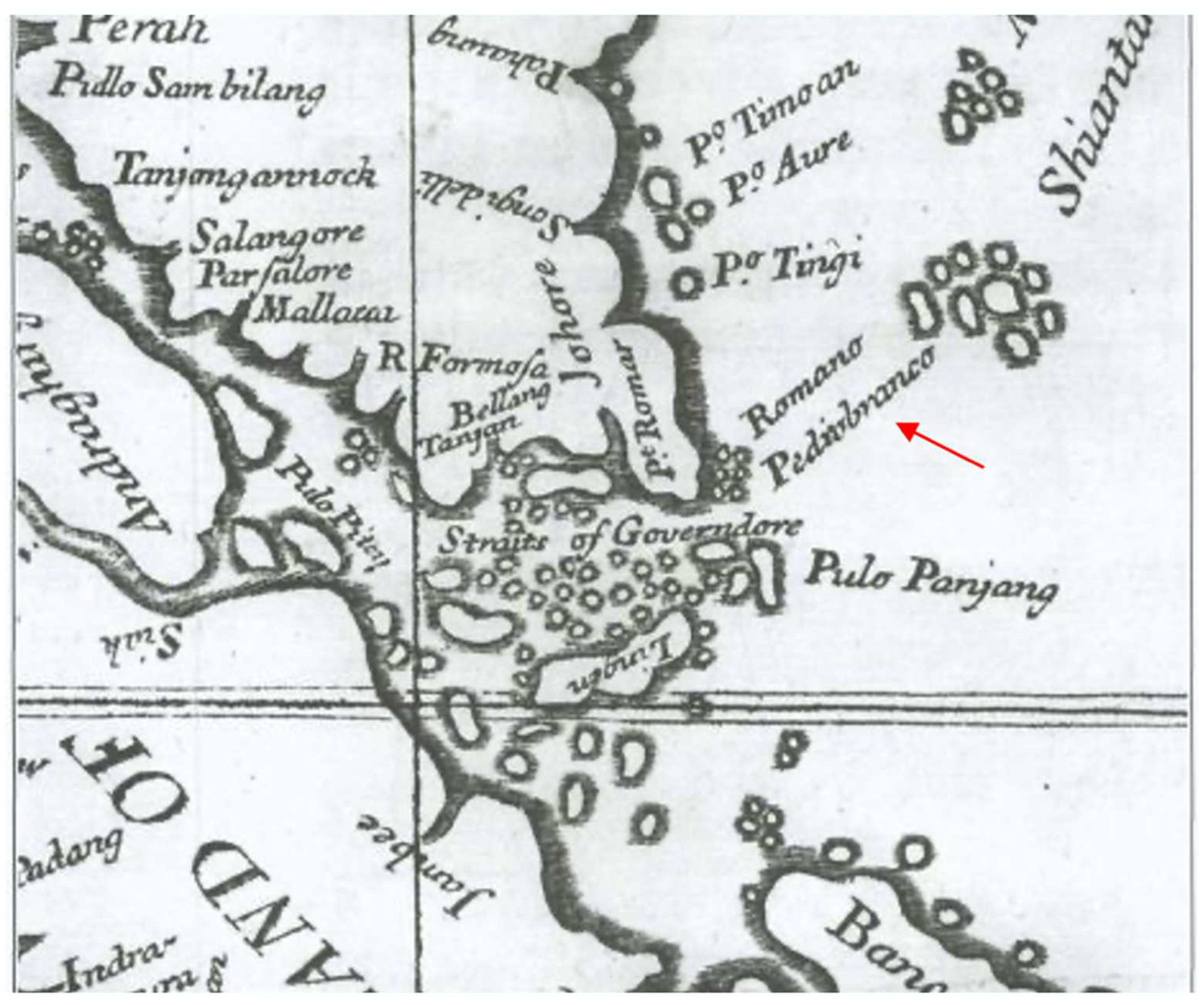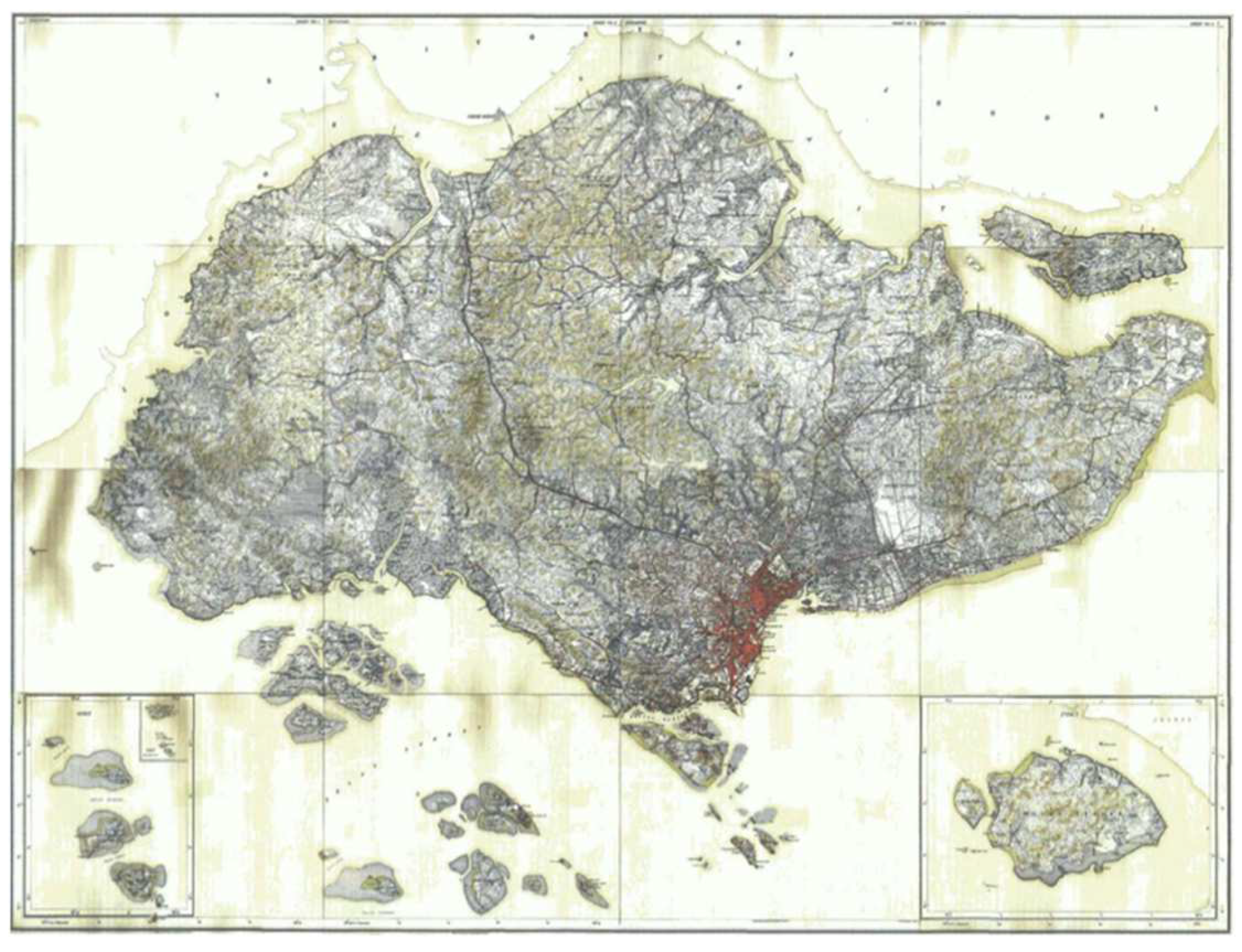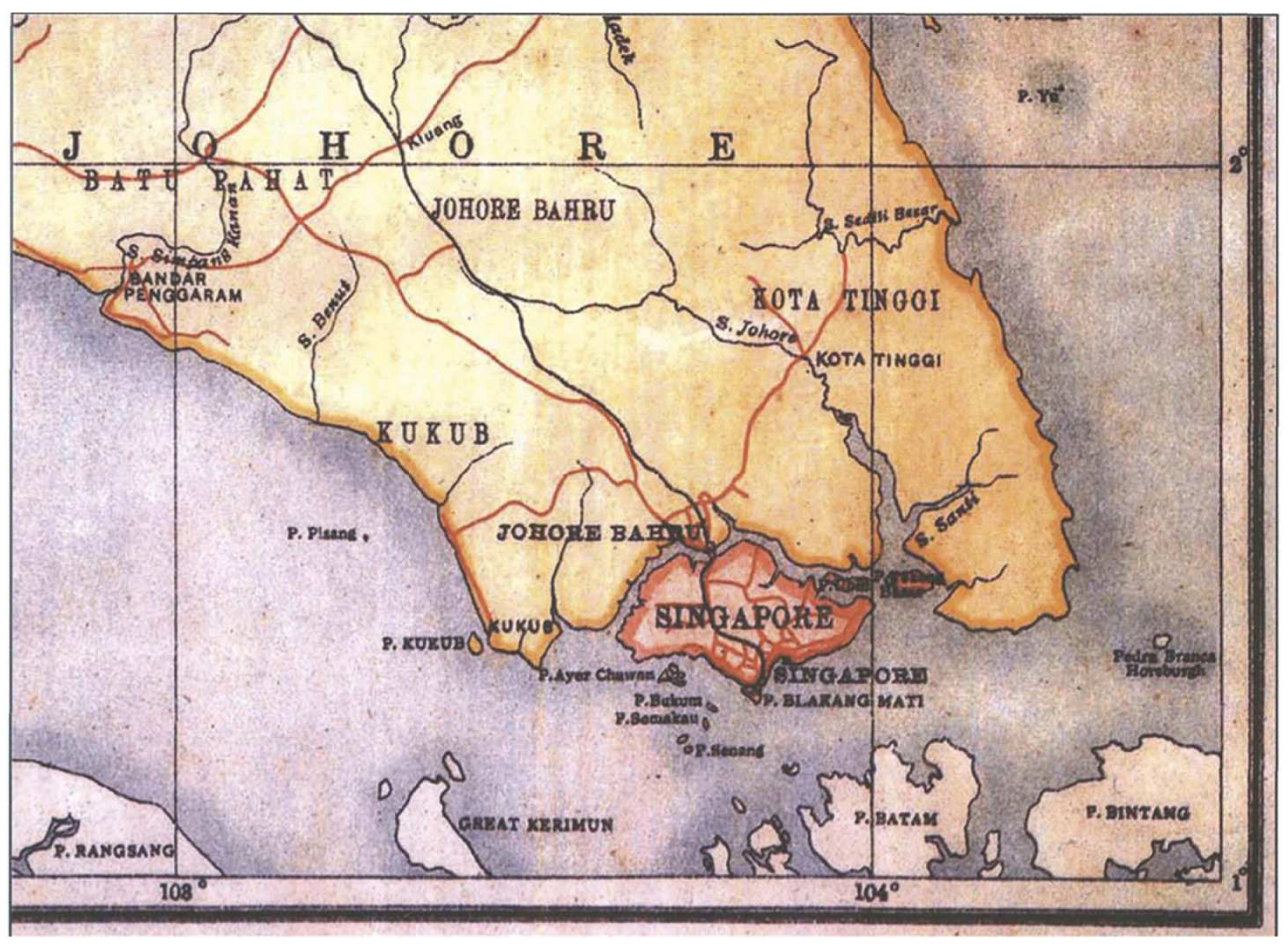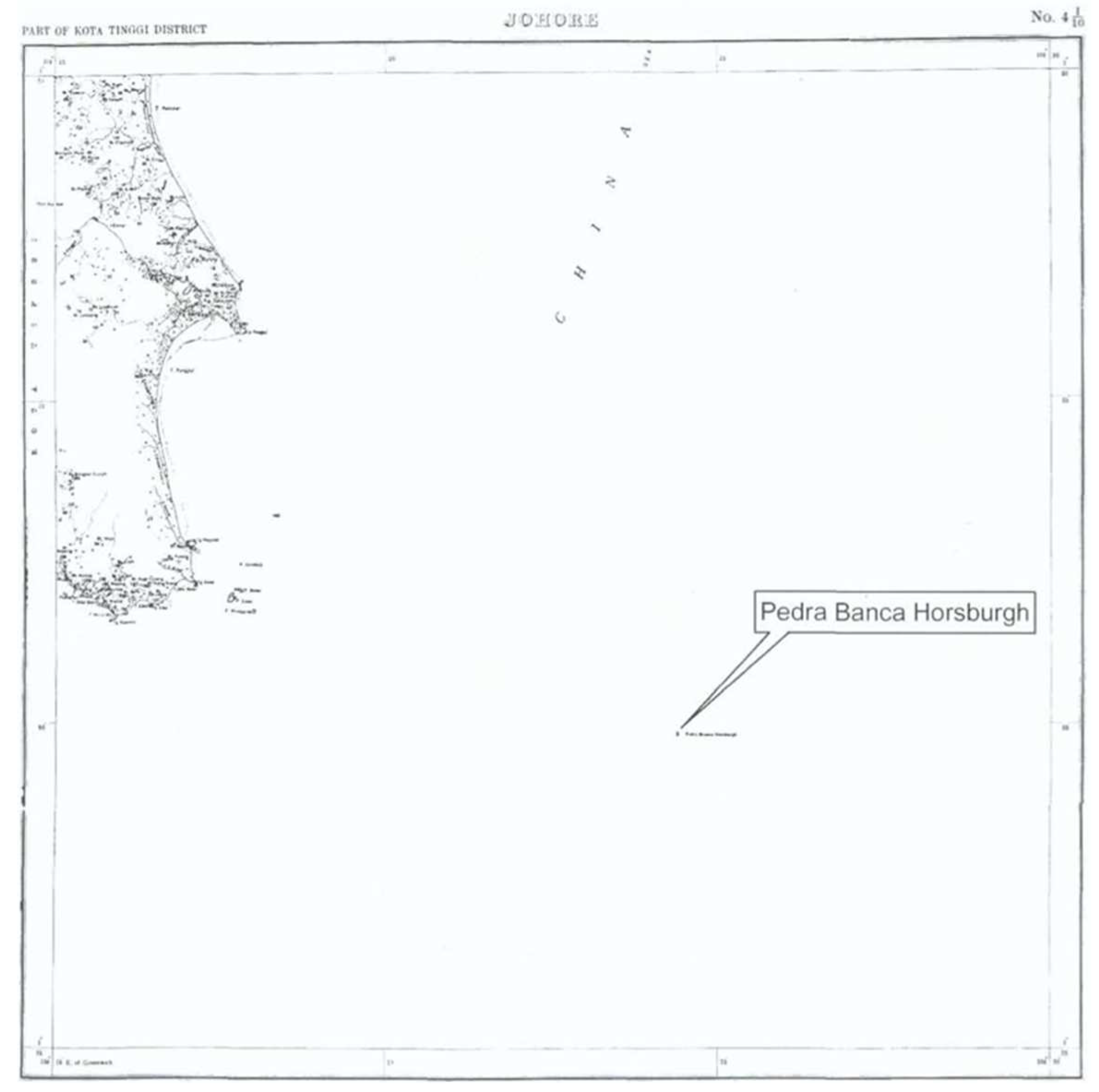Pedra Branca off Singapore: A Historical Cartographic Analysis of a Post-Colonial Territorially Disputed Island
Abstract
:1. Introduction
2. Background and Motivation
3. Ancient Beginnings: Singapore and Pedra Branca
3.1. Ancient China
“Zhèng Hé inform us that after leaving Lun Ya Men (Dragon’s Teeth Straits)—the narrow channel between Sentosa and Singapore island, which was the preferred route for Chinese mariners rounding the bottom of the Malay Peninsula—one should steer a course between 75° to 90° for five watches until the ship makes Bai Jiao (White Rock). One should then set a new course of 25° followed by 15° for another five watches, until one comes abreast of East Bamboo Mountain—one of the two peaks on Pulau Aur”.[32] (p. 86)
3.2. Portuguese and Dutch Empire
“From Malacca to Pulo Param it is five jãos, and from there to Pisang (Piçam) another five, and from Pulo Pisang to Karimun (Caryman) it is three jãos, and from Karimun to Singapore it is five, and from Singapore to Pedra Branca five, and from [Pedra Branca to] Pull Tingi (Tymge) five jãos to the north-east…”.[24] (p. 301)
“From the Cape of Singapura to the hook named Sinosura to the east, are 18 miles; 6 or 7 miles from there lies a cliffe in the sea called Pedra Bianque, or White Rock, where the shippes that come and goe from China doe oftentymes passe in greate danger and some are left upon it, whereby the Pilots when they come thither are in greate feare for other way than this they have not.”[42] (p. 119)
3.3. Dangers of the Region in the Modern World
4. The Horsburgh Lighthouse
4.1. Building Process, Challenges, and Completion
“In the Year of our Lord 1850andIn the 13th year of the Reign ofVictoriaQueen of Great Britain and Ireland,The Most NobleJames Andrew Marquis of Dalhousie, K.T.being Governor-General of British India,The Foundation Stone,of the Light-house to be erected at Pedra Brancaand dedicated to the Memory of the CelebratedHydrographer James Horsburgh, F.R.S.was laid on the 24th day of May, the anniversaryof the Birth-day of Her Most Gracious Majesty,by theWorshipful Master M.F. Davidson, Esq.,and theBrethren of the Lodge Zetland in the EastNo. 748.In the presence of the Governor of the StraitsSettlements and many of the British and Foreign Residents of SingaporeJ.T. Thomson,Architect.”
4.2. Legacy and Changes
5. The Pedra Branca Malaysia-Singapore Dispute
5.1. Nature of Dispute
5.2. Singapore’s Case
5.3. Malaysia’s Case
5.4. ICJ’s Decision
6. Conclusions
Author Contributions
Funding
Institutional Review Board Statement
Informed Consent Statement
Data Availability Statement
Conflicts of Interest
References
- Ministry of Foreign Affairs Singapore. Pedra Branca. Available online: https://www.mfa.gov.sg/SINGAPORES-FOREIGN-POLICY/Key-Issues/Pedra-Branca (accessed on 30 November 2021).
- Maritime and Port Authority of Singapore. Horsburgh Lighthouse. Available online: https://www.mpa.gov.sg/assets/mpa25/horsburgh_lh.html (accessed on 10 December 2021).
- Hall-Jones, J. The Horsburgh Lighthouse; Self Published: Invercargill, New Zealand, 1995. [Google Scholar]
- Lin, L.L.; Tan, X.L.; Teng, S.M.L. Case Study on the Dispute over Pedra Branca; Nanyang Technological University: Singapore, 2004. [Google Scholar]
- Jappalang, Pedra Branca Map. 2008, A Map Showing the Approximate Location of the Island of Pedra Branca, Which Is under the Sovereignty of Singapore, at the Eastern End of the Singapore Strait Where It Meets the South China Sea. Near It Are the Maritime Features Middle Rocks (under Malaysian Sovereignty) and South Ledge, and the Coasts of Johor, Malaysia, and Bintan, Indonesia. Available online: https://commons.wikimedia.org/wiki/File:Pedra_Branca_Map.svg (accessed on 5 December 2021).
- Mohamad, A.K. Case Concerning Sovereignty over Pedra Branca Pulau Batu Puteh. Middle Rocks and South Ledge; International Court of Justice: Kuala Lumpur, Malaysia, 2004. [Google Scholar]
- Jayakumar, S.; Koh, T.T.B. Pedra Branca: The Road to the World Court; NUS Press: Singapore, 2009. [Google Scholar]
- Cornelius-Takahama, V. Pedra Branca. Available online: https://eresources.nlb.gov.sg/infopedia/articles/SIP_722_2005-01-20.html (accessed on 30 November 2021).
- Chew, H.M. Pedra Branca Shipwrecks: How Singapore Divers Chanced upon Centuries-Old Artefacts Underwater. Available online: https://www.channelnewsasia.com/singapore/pedra-branca-shipwrecks-how-singapore-divers-chanced-upon-centuries-old-artefacts-underwater-2030201 (accessed on 30 November 2021).
- Sahni, A. Sunken Treasures Found in Singapore’s Waters. Available online: https://news.cgtn.com/news/2021-07-26/Sunken-treasures-found-in-Singapore-s-waters-12cVPBGa3u0/index.html (accessed on 30 November 2021).
- Santhi, S.; Saravanakumar, A. The Economic Development of Singapore: A Historical Perspective. Aut Aut Res. J. 2020, 11, 441–459. [Google Scholar]
- Cornelius-Takahama, V. Singapore Stone. Available online: https://eresources.nlb.gov.sg/infopedia/articles/SIP_43_2005-01-26.html (accessed on 30 November 2021).
- Chua, S.H. Crypto-Linguistics in Singapore: Deciphering the Singapore Stone; Nanyang Technological University: Singapore, 2018. [Google Scholar]
- Protection for Artefacts Still to Be Found. Available online: https://www.straitstimes.com/opinion/st-editorial/protection-for-artefacts-still-to-be-found (accessed on 10 November 2021).
- Tan, J. Port of Singapore. Available online: https://eresources.nlb.gov.sg/infopedia/articles/SIP_2018-04-20_085007.html (accessed on 14 December 2021).
- Roolvink, R. The variant versions of the Malay Annals. Bijdr. Tot De Taal Land En Volkenkd. J. Humanit. Soc. Sci. Southeast Asia 1967, 123, 301–324. [Google Scholar] [CrossRef] [Green Version]
- Brown, C.C. The Malay Annals. J. Malay. Branch R. Asiat. Soc. 1952, 25, 5–276. [Google Scholar]
- Winstedt, R.O. The Malay Annals of Sejarah Melayu. J. Malay. Branch R. Asiat. Soc. 1938, 16, 1–226. [Google Scholar]
- Leyden, J. Malay Annals: Translated from the Malay Language; Longman, Hurst, Rees, Orme, and Brown: London, UK, 1821. [Google Scholar]
- Liaw, Y.F. A History of Classical Malay Literature/Liaw Yock Fang; Bahari, R.; Aveling, H., Translators; Institute of Southeast Asian Studies: Singapore, 2013. [Google Scholar]
- Perono Cacciafoco, F.; Shia, D. Singapore Pre-colonial Place Names: A Philological Reconstruction Developed through the Analysis of Historical Maps. Rev. Hist. Geogr. Toponomast. 2020, 15, 79–120. [Google Scholar]
- Lim, C.; Tan, A.Y.P.; Lim-Yang, R. Attack of the Swordfish and Other Singapore Tales; National Heritage Board: Singapore, 2005. [Google Scholar]
- Kartapranata, G. The Historical Map of Malacca Sultanate (1402–1511) Malay Peninsula and East Coast of Sumatra. 2011, The Historical Map of Malacca Sultanate (1402–1511) Malay Peninsula and East Coast of Sumatra. Made and Improved Based on “Atlas Sejarah Indonesia dan Dunia” (The Atlas of Indonesian and World History), PT Pembina Peraga Jakarta 1996. Available online: https://commons.wikimedia.org/wiki/File:Malacca_Sultanate_en.svg (accessed on 6 November 2021).
- Pires, T.; Rodrigues, F. The Suma Oriental of Tome Pires and The Book of Francisco Rodrigues; Cortesao, A., Ed.; Asian Educational Services: New Delhi, India, 2005. [Google Scholar]
- Brezina, C. Zhèng Hé: China’s Greatest Explorer, Mariner, and Navigator; Rosen Publishing Group: New York, NY, USA, 2016. [Google Scholar]
- Gronewald, S. The Ming Voyagers. Available online: http://afe.easia.columbia.edu/special/china_1000ce_mingvoyages.htm (accessed on 18 December 2021).
- Subrahmanyam, S. The Portuguese Empire in Asia, 1500–1700: A Political and Economic History; Longman: London, UK, 1993. [Google Scholar]
- Yang, W. Maritime Asia: Admiral Zhèng Hé’s Voyages to the “West oceans”. Educ. About Asia 2014, 19, 26–30. [Google Scholar]
- Hrubý, J. Establishing a Common Ground—Admiral Zhèng Hé as an Agent of Cultural Diplomacy in Malaysia. In Transnational Sites of China’s Cultural Diplomacy; Springer: Singapore, 2020; pp. 89–113. [Google Scholar]
- Máo, Y.; Wu, B.Z. Available online: https://www.loc.gov/resource/g7821rm.gct00058/?sp=14&r=-0.743,0.44,2.486,1.099,0 (accessed on 20 November 2021).
- Perono Cacciafoco, F.; Gan, C. Naming Singapore: A Historical Survey on the Naming and Re-Naming Process of the Lion City. An. Univ. Din Craiova Ser. Ştiinţe Filol. 2020, 42, 125–139. [Google Scholar]
- Davison, J. Between a Rock and a Hard Place. Expat 2008, 86–94. Available online: https://web.archive.org/web/20081001162749/http://www.theexpat.com/magazine/July08_086_PedraBranca.pdf (accessed on 5 December 2021).
- Anonymous. Chinese Woodblock Print, Representing Zhèng Hé’s Ships (中国木板画所刻郑和号). Early 17th century. Available online: https://commons.wikimedia.org/wiki/File:ZhengHeShips.gif (accessed on 5 December 2021).
- Máo, Y. Treatise on Armament Technology or Records of Armaments and Military Provisions (Wu Bei Zhi; 武備志). 1621. Available online: https://www.loc.gov/item/2004633695/ (accessed on 5 December 2021).
- Diffie, B.W.; Winius, G.D. Foundations of the Portuguese Empire, 1415–1580; University of Minnesota Press: Minneapolis, MN, USA, 1977. [Google Scholar]
- Franz-Stefan, G. How Portugal Forged an Empire in Asia. Available online: https://thediplomat.com/2019/07/how-portugal-forged-an-empire-in-asia (accessed on 14 December 2021).
- Daniell, T.; Daniell, W. Pedra Branca, Straits of Malacca. 1820, An Etching of Pedra Branca before the Building of Horsburgh Lighthouse, with Dark Storm Clouds in the Background. Available online: https://commons.wikimedia.org/wiki/File:PedraBranca-Daniell-c1820-detail.jpg (accessed on 5 December 2021).
- Jonkers, A.R.T. Earth’s Magnetism in the Age of Sail; Johns Hopkins University Press: Baltimore, MD, USA, 2003. [Google Scholar]
- Koeman, C. Jan Huygen Van Linschoten; UC Biblioteca Geral: Coimbra, Portugal, 1984. [Google Scholar]
- Kamps, I. Jan Huyghen Van Linschoten. In Travel Knowledge: European “Discoveries” in the Early Modern Period; Kamps, I., Singh, J.G., Eds.; Palgrave Macmillan US: New York, NY, USA, 2001; pp. 149–159. [Google Scholar]
- Saldanha, A. The Itineraries of Geography: Jan Huygen van Linschoten’s “Itinerario” and Dutch Expeditions to the Indian Ocean, 1594–1602. Ann. Assoc. Am. Geogr. 2011, 101, 149–177. [Google Scholar] [CrossRef]
- Van Linschoten, J.H.; Burnell, A.C. (Eds.) The Voyage of John Huyghen van Linschoten to the East Indies: From the Old English Translation of 1598. The First Book, Containing His Description of the East. In Two Volumes Volume I; Hakluyt Society: London, UK, 1885. [Google Scholar]
- Gerritz, H. Map of Sumatra. 1620, Detail of a “Map of Sumatra” showing the island of “Pedrablanca” (Pedra Branca) by Hessel Gerritz, a cartographer of the Hydrographic Service of the Dutch East India Company. Available online: https://commons.wikimedia.org/wiki/File:Hessel_Gerritsz,Map_of_Sumatra_showing_Pedra_Branca_(1620).jpg (accessed on 6 November 2021).
- De Ataide, J.; Teixeira, J. 1630 Portuguese Map of Asia. Taboas Geraes de Toda A Navegação 1630, 1630 Portuguese Map of Asia, Entitled Taboas Geraes de Toda a Navegação, Divididas e Emendadas por Dom Ieronimo de Attayde com Todos os Portos Principaes das Conquistas de Portugal Delineadas por Ioão Teixeira Cosmographo de Sua Magestade, anno de 1630 (General Tables of All the Navigation, Divided and Corrected by D. Jeronimo de Ataide, with all the Ports and Conquests of Portugal Delineated by Joao Teixeira, Cosmographer of His Majesty, Year 1630. Available online: https://commons.wikimedia.org/wiki/File:Portuguese_map_of_Asia,_1630.jpg (accessed on 6 November 2021).
- Hamilton, A. A Map of the Dominions of Johore and of the Island of Sumatra with the Adjacent Islands. 1727, Detail of Alexander Hamilton’s “A Map of the Dominions of Johore and of the Island of Sumatra with the Adjacent Islands” Showing the Island of “Pedrobranco” (Pedra Branca). Available online: https://en.wikipedia.org/wiki/File:PedraBranca-MapofDominionsofJohore-Hamilton-1727.jpg (accessed on 6 November 2021).
- Bellin, J.-N. Jacques-Nicolas Bellin Map of the Straits of Malacca. 1755. Available online: https://www.roots.gov.sg/stories-landing/stories/geo-graphic-celebrating-maps-and-their-stories/story (accessed on 6 November 2021).
- Rîșteiu, N.T.; Creţan, R.; O’Brien, T. Contesting post-communist economic development: Gold extraction, local community, and rural decline in Romania. Eurasian Geogr. Econ. 2021, 1–23. [Google Scholar] [CrossRef]
- Mulliner, K.; The-Mulliner, L. Historical Dictionary of Singapore; Scarecrow Press: Metuchen, NJ, USA, 1991. [Google Scholar]
- Sather, C. The Orang Laut; Academy of Social Sciences in cooperation with Universiti Sains Malaysia, Royal Netherlands Government: Penang, Malaysia, 1999.
- Barnouw, A.J. Cross Currents of Culture in Indonesia. Far East. Q. 1946, 5, 143–151. [Google Scholar] [CrossRef]
- Thomson, J.T. Account of the Horsburgh Light-house. J. Indian Archipel. East. Asia 1852, 6, 427–428. [Google Scholar]
- Lee, S.T. Forum: Build Replica of Horsburgh Lighthouse to House a Maritime Museum. Available online: https://www.straitstimes.com/opinion/forum/forum-build-replica-of-horsburgh-lighthouse-to-house-a-maritime-museum (accessed on 20 December 2021).
- Chee, C.H. Singapore’s Foreign Policy, 1965–1968. J. Southeast Asian Hist. 1969, 10, 177–191. [Google Scholar] [CrossRef]
- United Nations. Agreement Relating to the Separation of Singapore from Malaysia as an Independent and Sovereign State. 1965. Available online: https://treaties.un.org/doc/Publication/UNTS/Volume%20563/volume-563-I-8206-English.pdf (accessed on 20 December 2021).
- United Nations. 168. Case Concerning Sovereignty over Pedra Branca/Pulau Batu Puteh, Middle Rocks and South Ledge (Malaysia/Singapore). In Summaries of Judgments, Advisory Opinions and Orders of the International Court of Justice 2008–2012; United Nations: New York, NY, USA, 2013. [Google Scholar]
- Koh, T. Case Concerning Sovereignty over Pedra Branca I Pulau Batu Puteh, Middle Rocks and South Ledge (Malaysia/Singapore); International Court of Justice: Singapore, 2004. [Google Scholar]
- Jayakumar, S. Oral argument by Prof S. Jayakumar, Deputy Prime Minister, Co-ordinating Minister for National Security and Minister for Law of the Republic of Singapore. Available online: https://www.mfa.gov.sg/Newsroom/Press-Statements-Transcripts-and-Photos/2007/11/OralArgumentByProfSJayakumarDeputyPrimeMinisterCo-ordinatingMinister-press-200711-13 (accessed on 20 December 2021).
- Banner, S. Why Terra Nullius? Anthropology and Property Law in Early Australia. Law Hist. Rev. 2005, 23, 95–131. [Google Scholar] [CrossRef] [Green Version]
- Borch, M. Rethinking the origins of terra nullius. Aust. Hist. Stud. 2001, 32, 222–239. [Google Scholar] [CrossRef]
- Buchan, B.; Heath, M. Savagery and Civilization:From Terra Nullius to the ‘Tide of History’. Ethnicities 2006, 6, 5–26. [Google Scholar] [CrossRef]
- Tanaka, Y. Passing of Sovereignty: The Malaysia/Singapore Territorial Dispute before the ICJ. Hague Justice J. 2008, 3, 103–113. [Google Scholar] [CrossRef]
- Surveyor General of the Federated Malay States. Map of Singapore with Island, Including Insets. 1923–1924, p. 142. Available online: https://www.icj-cij.org/public/files/case-related/130/14139.pdf (accessed on 19 December 2021).
- Surveyor General of the Federated Malay States. Map of Malaya. 1925, p. 144. Available online: https://www.icj-cij.org/public/files/case-related/130/14139.pdf (accessed on 19 December 2021).
- Ibrahim, A.-M. Johore, Part of Kota Tinggi District. 1926, p. 145. Available online: https://www.icj-cij.org/public/files/case-related/130/14139.pdf (accessed on 19 December 2021).
- Teoh, S. Malaysia to Study Options on Pedra Branca, 13 Years after ICJ Decision to Award It S’pore. Available online: https://www.straitstimes.com/asia/se-asia/malaysia-looking-into-reviving-pedra-branca-claim (accessed on 19 December 2021).
- Creţan, R. Toponimie Geografica Geographical Toponymy; Editura Mirton: Timişoara, Romania, 2000. [Google Scholar]
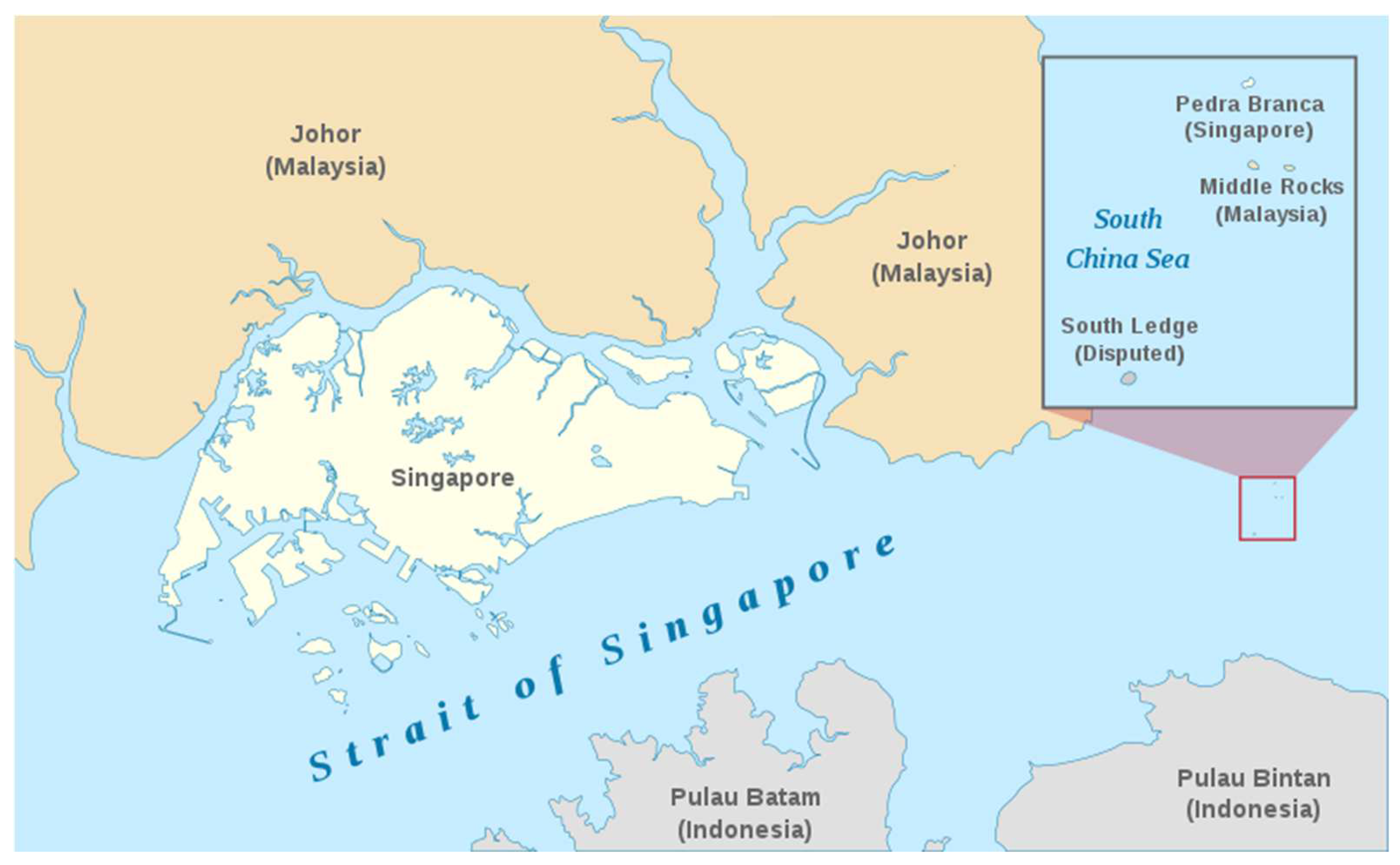
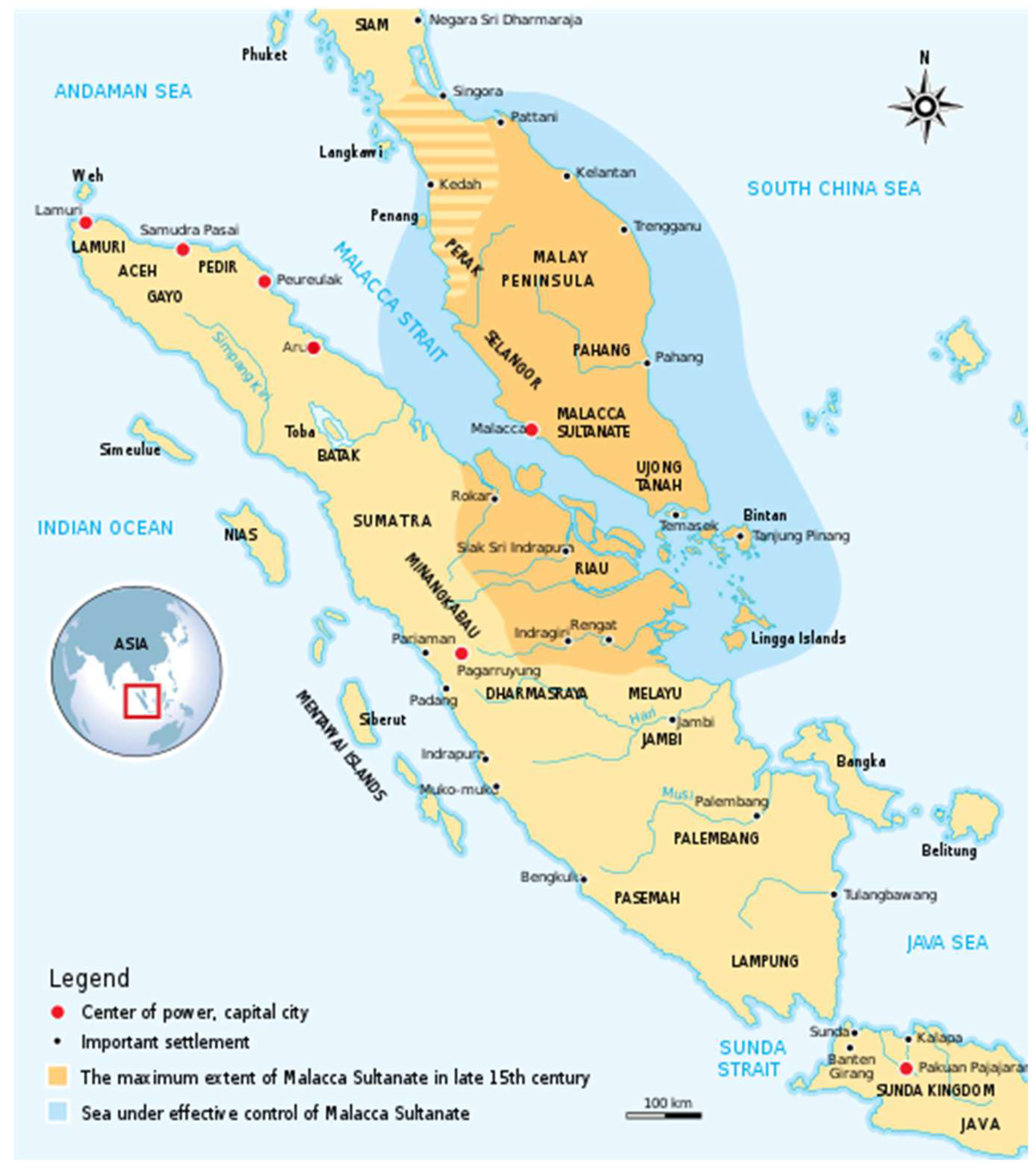
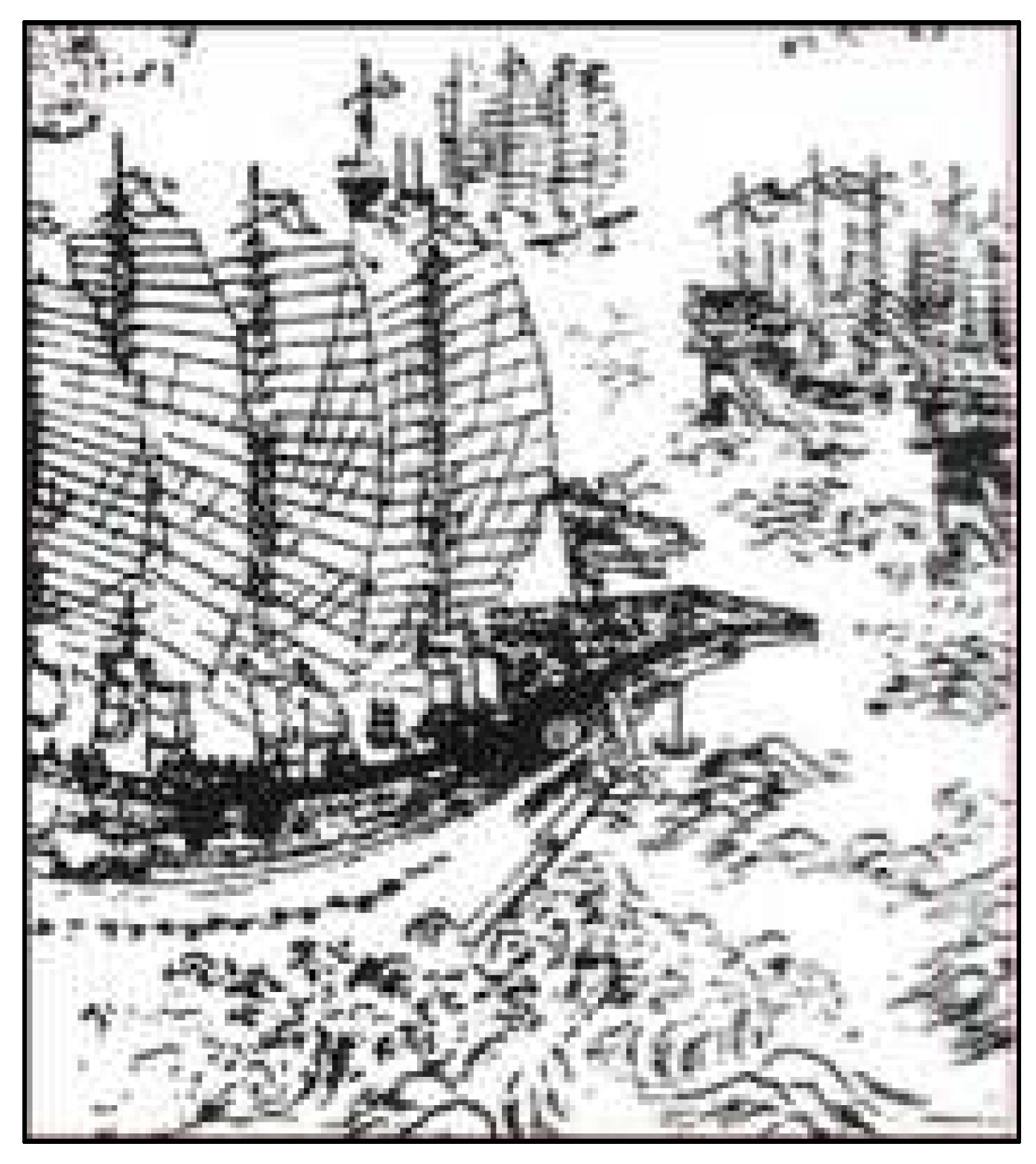

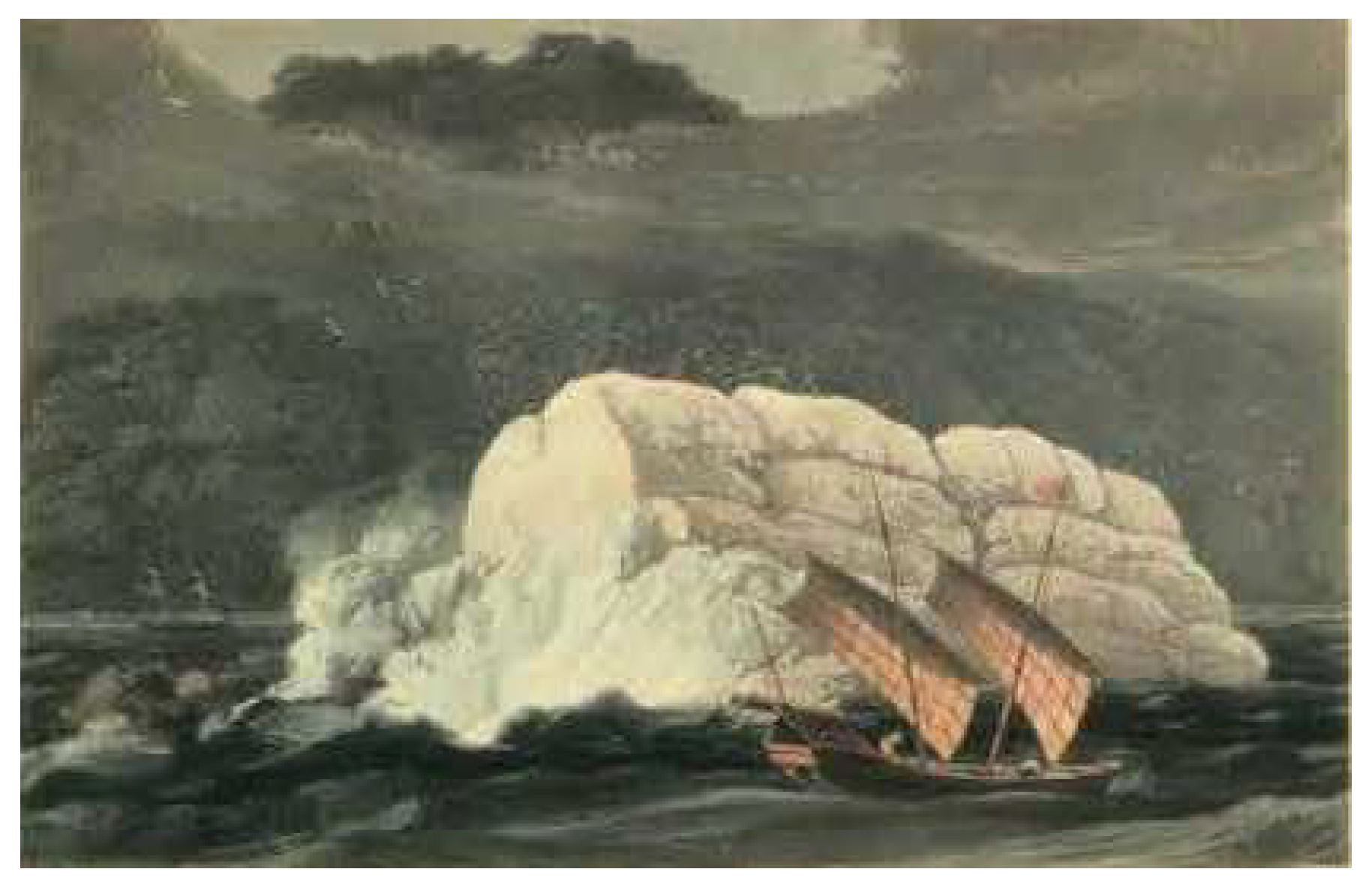
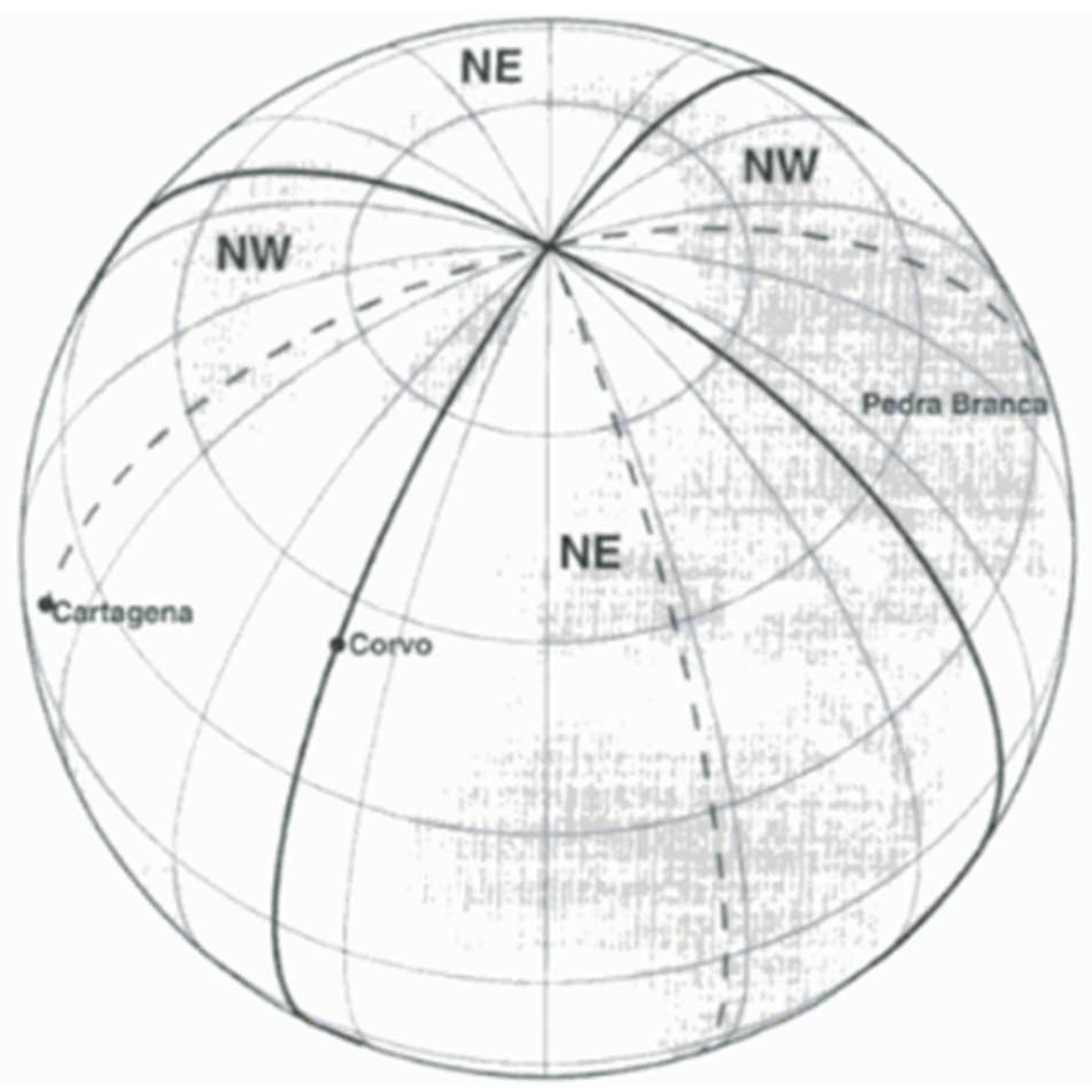
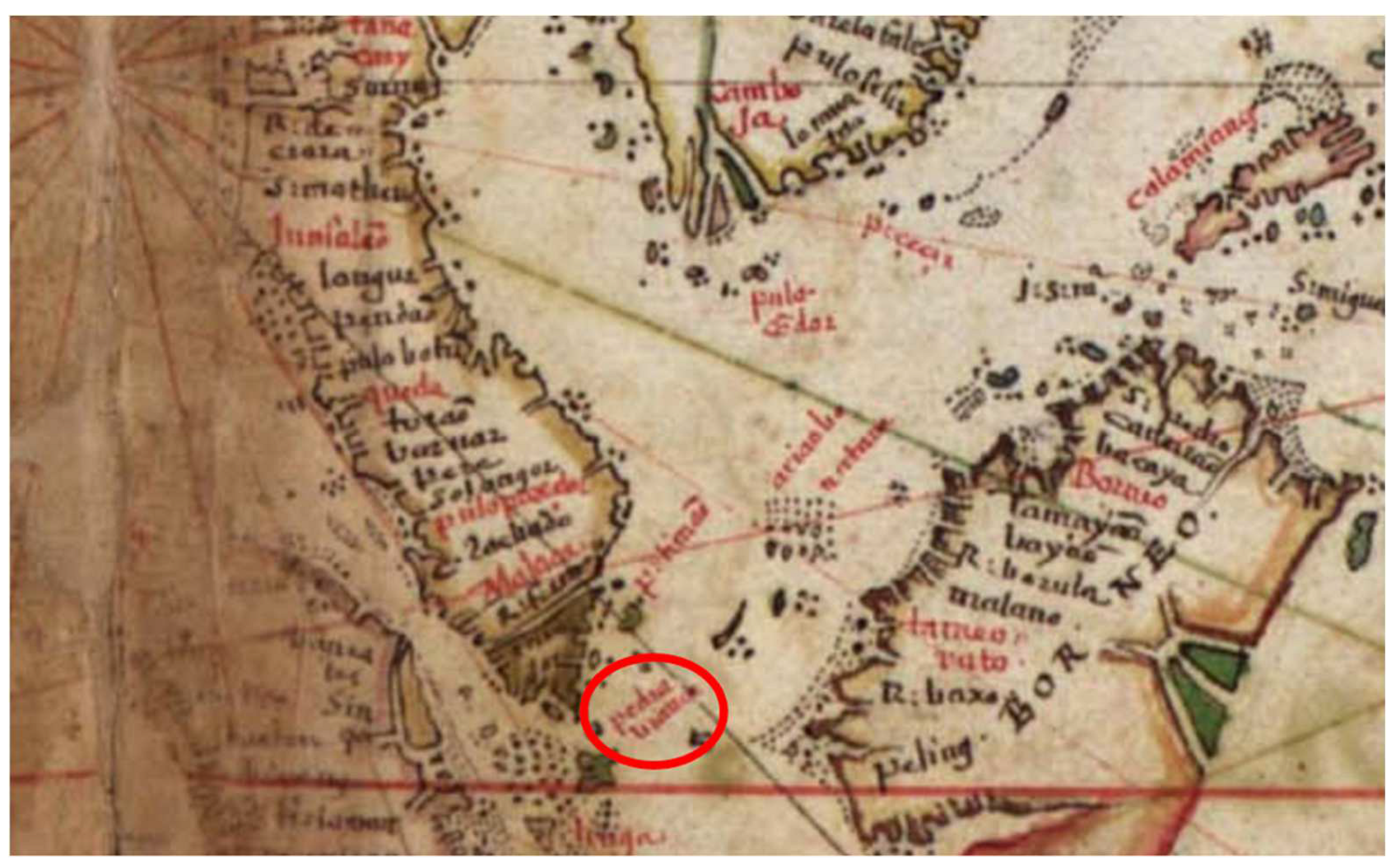
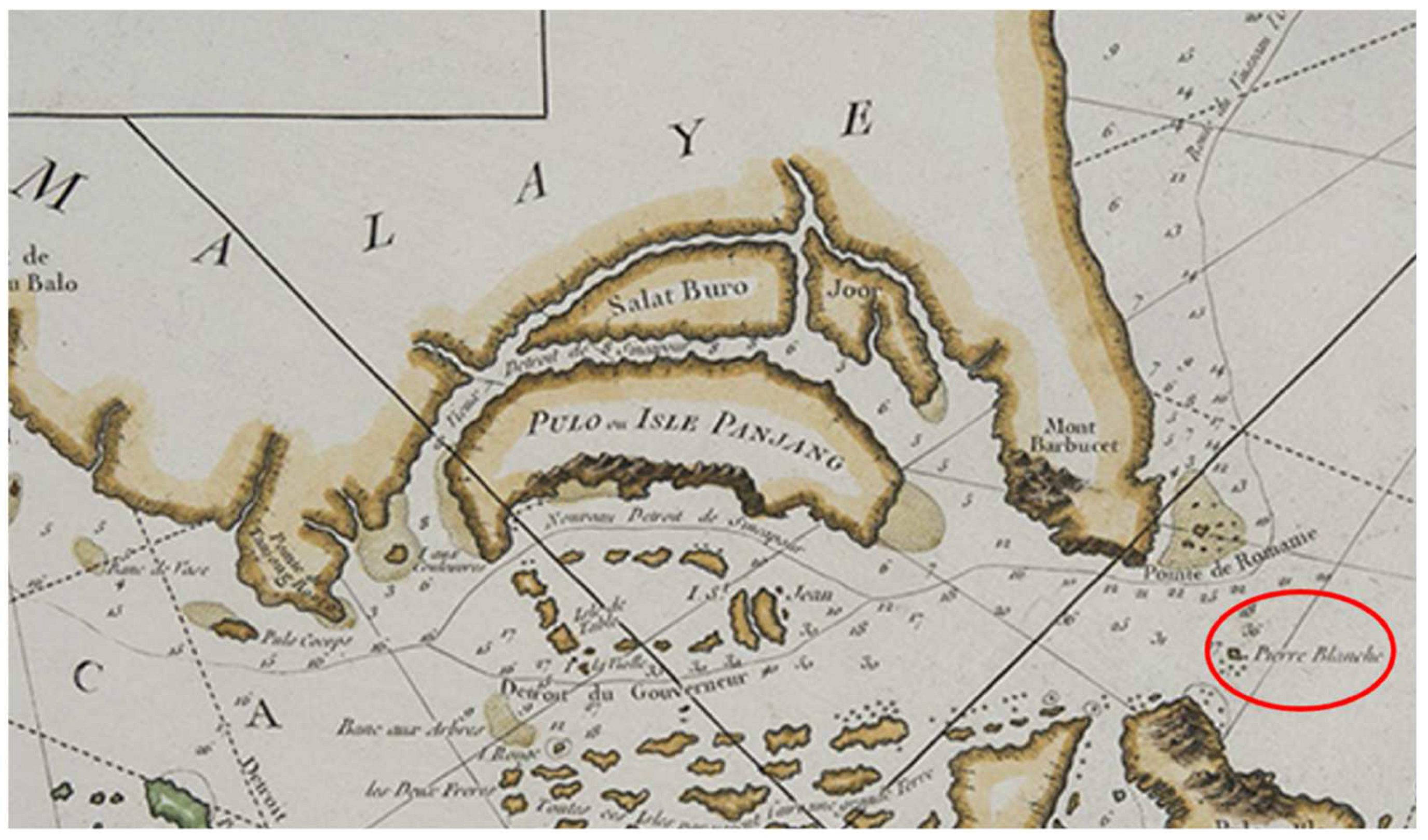
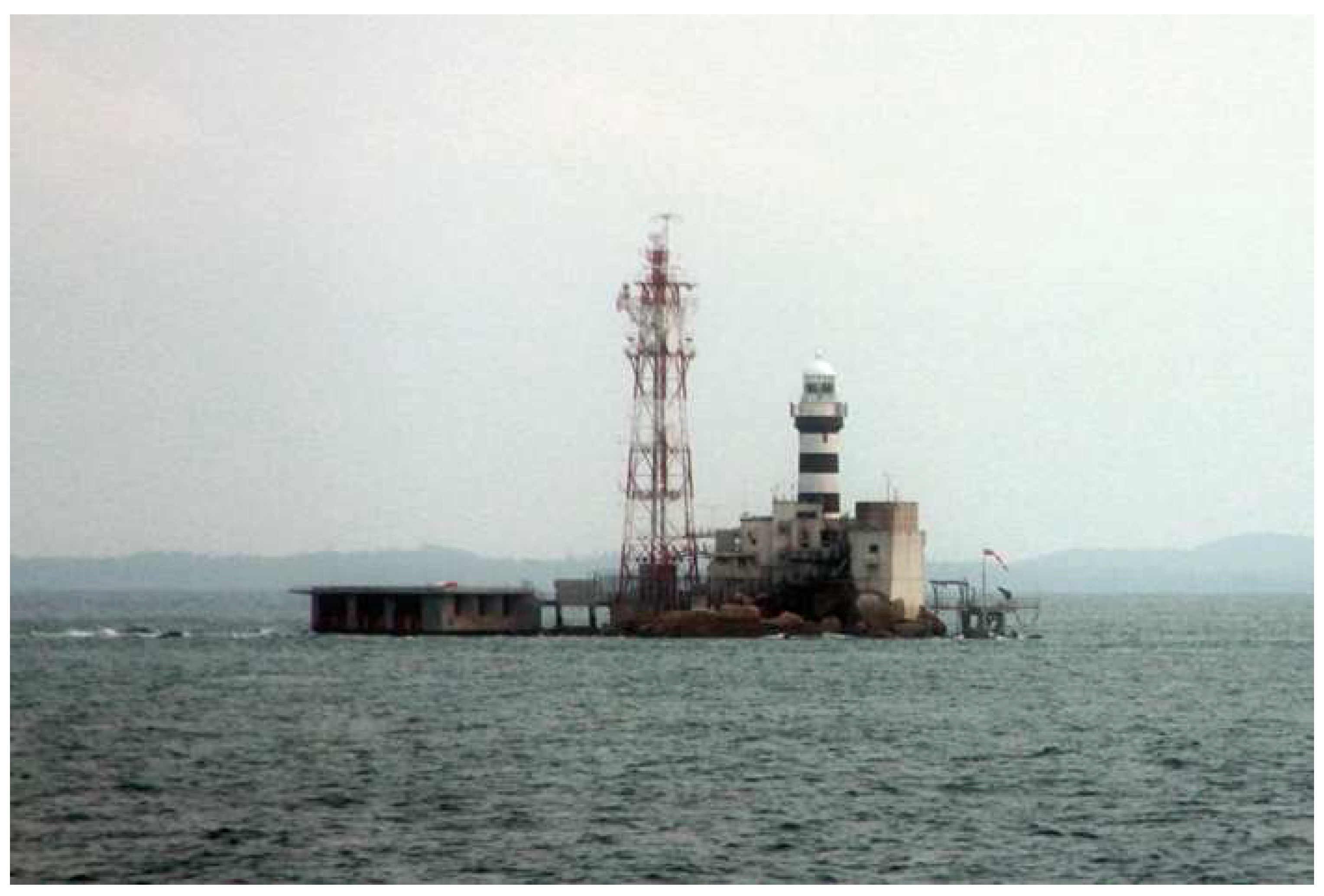
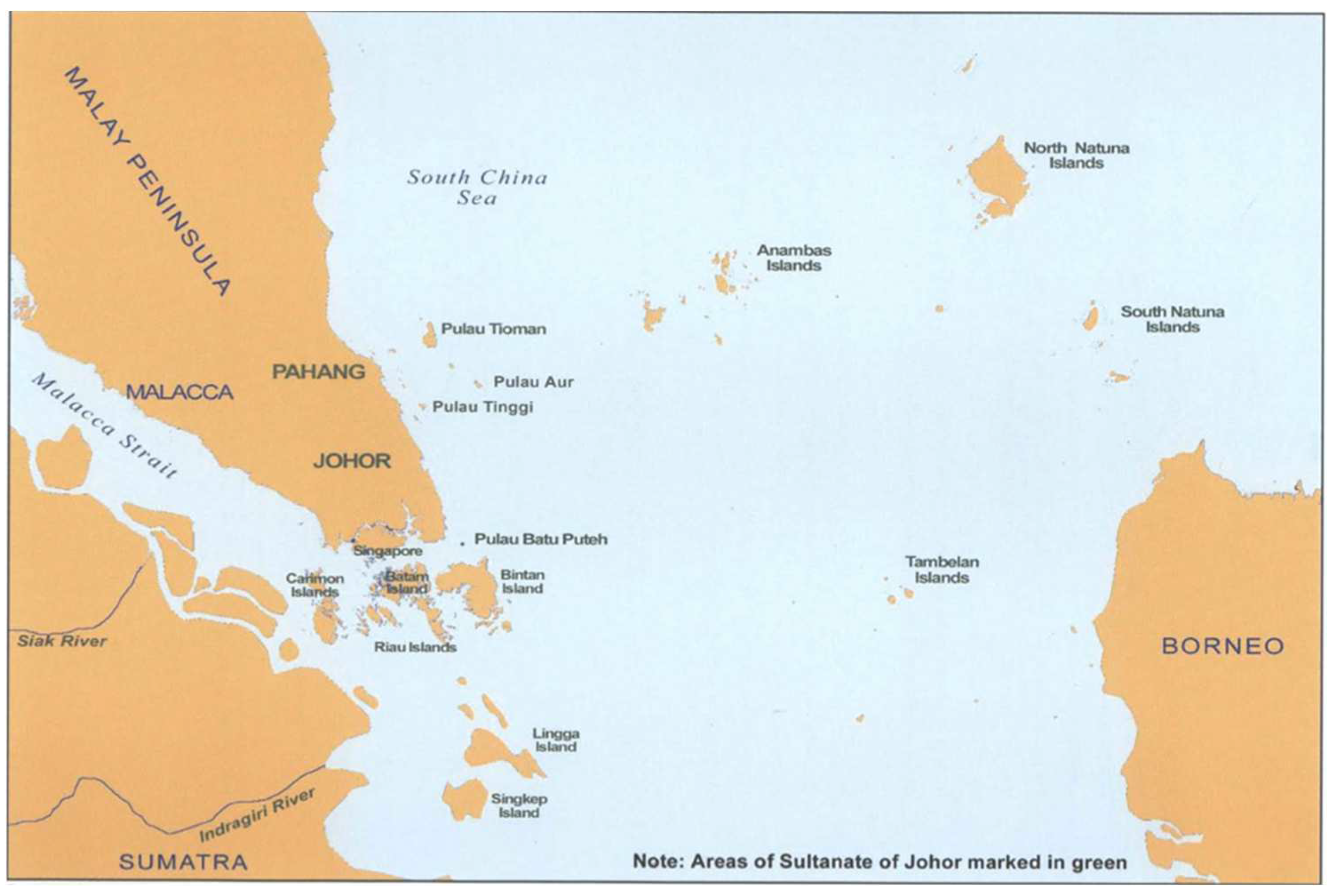
Publisher’s Note: MDPI stays neutral with regard to jurisdictional claims in published maps and institutional affiliations. |
© 2022 by the authors. Licensee MDPI, Basel, Switzerland. This article is an open access article distributed under the terms and conditions of the Creative Commons Attribution (CC BY) license (https://creativecommons.org/licenses/by/4.0/).
Share and Cite
Ong, B.M.Q.; Perono Cacciafoco, F. Pedra Branca off Singapore: A Historical Cartographic Analysis of a Post-Colonial Territorially Disputed Island. Histories 2022, 2, 47-67. https://doi.org/10.3390/histories2010005
Ong BMQ, Perono Cacciafoco F. Pedra Branca off Singapore: A Historical Cartographic Analysis of a Post-Colonial Territorially Disputed Island. Histories. 2022; 2(1):47-67. https://doi.org/10.3390/histories2010005
Chicago/Turabian StyleOng, Brenda Man Qing, and Francesco Perono Cacciafoco. 2022. "Pedra Branca off Singapore: A Historical Cartographic Analysis of a Post-Colonial Territorially Disputed Island" Histories 2, no. 1: 47-67. https://doi.org/10.3390/histories2010005
APA StyleOng, B. M. Q., & Perono Cacciafoco, F. (2022). Pedra Branca off Singapore: A Historical Cartographic Analysis of a Post-Colonial Territorially Disputed Island. Histories, 2(1), 47-67. https://doi.org/10.3390/histories2010005






